You Deserve Better Value, Health & Balance
Harness the Holidays and de-stress with these green building ideas to manage your extra decorating and entertaining costs or you’ll end up with financial troubles in January – and beyond.
In this series, we’ll focus upon one of 12 smart ways to give yourself Holiday Breaks at Home:
Q: We want to be good earth stewards, should we go artificial or cut a tree?
A: Neither. Actually the most eco-friendly way to enjoy Christmas is to buy a live tree with its roots intact from a local grower, and then replant it in your garden after the holidays.
Live Christmas Tree Benefits
- With Live Trees you avoid lead or other plastic additive exposure. Some artificial trees contain materials that are tied to brain and organ health problems. Imagine lead dust settling upon your ornaments, gifts and floors. That can be un-knowingly tracked and even ingested by the family.
- Live Trees contain No PVCs. 85% of fake U.S.trees are made in China. Factory workers are routinely exposed to toxic polyvinyl chloride (PVC) chemicals during manufacturing which is certainly an unwanted gift for them.
- Live trees smell better. Live plants have a stronger seasonal fragrance. The crisp smell of Juniper or aromatic cedar will fill the room and get everybody in a jolly spirit.
- Live trees keep on giving. While indoors, they produce refreshing oxygen, while scrubbing out unwanted carbon dioxide. When planted, they grow and can enhance your cooking (rosemary) or provide privacy screening or shading. Oh, and for upcoming decades they keep providing oxygen and cleaning the air of greenhouse gases.
- Live trees help wildlife. In the bleak mid-winter, the critters outdoors need help. Your live tree will give wildlife a boost by providing a rich supply of food and shelter from harsh winds and cold temperatures.
Here’s a list of my favorite plants for live Christmas Trees (in no particular order):
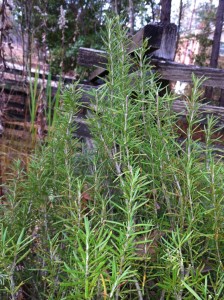 Rosemary [Rosmarinus officinalis] Great for a table top or buffet area tree. In time grows into a medium shrub up to 5 feet tall. Rosemary is a woody, perennial herb with wonderfully fragrant, evergreen needle-like leaves. Called “the dew of the sea” because it needs no water other than the humidity carried by the Mediterranean sea breeze, rosemary is drought tolerant. Once in the garden, enjoy its flowers, and has many culinary and medical uses. The plant is said to improve the memory and is used as a symbol of remembrance.
Rosemary [Rosmarinus officinalis] Great for a table top or buffet area tree. In time grows into a medium shrub up to 5 feet tall. Rosemary is a woody, perennial herb with wonderfully fragrant, evergreen needle-like leaves. Called “the dew of the sea” because it needs no water other than the humidity carried by the Mediterranean sea breeze, rosemary is drought tolerant. Once in the garden, enjoy its flowers, and has many culinary and medical uses. The plant is said to improve the memory and is used as a symbol of remembrance.
Blue Arrow Red Cedar [Juniperus virginiana 'Blue Arrow'] If you have limited space, ‘Blue Arrow’ is the right choice for narrow areas inside your home like front entrance halls. In time it quickly grows into a shrub 12-15 feet tall, 2 feet wide. Narrow, upright and super easy to grow makes this a distinctive blue-green specimen in your yard. ‘Blue Arrow’ is an improved native that easily tolerates seashore and roadside salty conditions and is drought and deer resistant. Fall berries are sought after by native songbirds.
Spartan Chinese Juniper [Juniperus chinensis ‘Spartan’] Choose this for its classic dark green needles. Great for a tall but narrow areas indoors (so you have more room for presents!) In time grows into a large shrub 15-20 feet tall, 3-5 feet wide in full sun. This fast growing columnar plant is heat, cold, drought, and salt tolerant. Attracts birds, but resists deer. Excellent for windbreaks, privacy screens, and topiary.
Dwarf Burford Holly [Ilex cornuta ‘Burfordii Nana’] 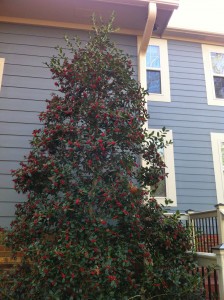 Hollies are the most popular of all winter decoration. Covered in gorgeous red berries and readily available in many sizes. Shiny, medium texture, but beware the glossy leaves have spines. In time grows into a large shrub 6-9 feet and trainable into a classic conical evergreen Christmas tree. Resists diseases and will tolerate shade. Waterwise and drought tolerant.
Hollies are the most popular of all winter decoration. Covered in gorgeous red berries and readily available in many sizes. Shiny, medium texture, but beware the glossy leaves have spines. In time grows into a large shrub 6-9 feet and trainable into a classic conical evergreen Christmas tree. Resists diseases and will tolerate shade. Waterwise and drought tolerant.
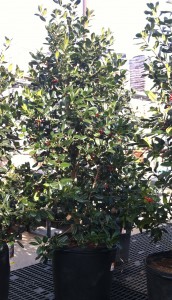 Nellie Stevens Holly [Ilex x. ‘Nellie R. Stevens’] Again, depending upon how large of an indoor tree you want, many sizes are readily available. It’s berries are orange-red and has dark green glossy evergreen foliage. In time grows into a tree 15-20 feet tall, 10 ft wide. Fast grower but during extreme heat need regular watering. Be aware this holly also has small spines. It requires a male pollinator plant nearby if you want berries next year.
Nellie Stevens Holly [Ilex x. ‘Nellie R. Stevens’] Again, depending upon how large of an indoor tree you want, many sizes are readily available. It’s berries are orange-red and has dark green glossy evergreen foliage. In time grows into a tree 15-20 feet tall, 10 ft wide. Fast grower but during extreme heat need regular watering. Be aware this holly also has small spines. It requires a male pollinator plant nearby if you want berries next year.
Little Gem Southern Magnolia [Magnolia grandiflora ‘Little Gem’]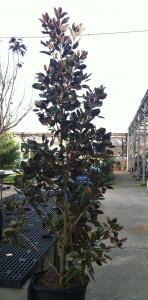 Nothing, I mean, nothing makes for a more southern Christmas than to decorate inside with southern magnolia. ‘Little Gem’ is a perfect specimen for both a live Christmas tree and your yard. Its coarse texture with dark green leathery leaves on top and lovely cinnamon-brown underneath is perfect for hanging your ornaments and lights. In time it slowly grows into a small tree 15-20 feet tall, 8-10 feet wide. In July you’ll be rewarded, even as a young plant, with fragrant white flowers. Shape it periodically to keep it’s dense upright shape and you will feel like your yard has a distinct pedigree.
Nothing, I mean, nothing makes for a more southern Christmas than to decorate inside with southern magnolia. ‘Little Gem’ is a perfect specimen for both a live Christmas tree and your yard. Its coarse texture with dark green leathery leaves on top and lovely cinnamon-brown underneath is perfect for hanging your ornaments and lights. In time it slowly grows into a small tree 15-20 feet tall, 8-10 feet wide. In July you’ll be rewarded, even as a young plant, with fragrant white flowers. Shape it periodically to keep it’s dense upright shape and you will feel like your yard has a distinct pedigree.
Live Christmas Tree Care
It goes without saying that dry indoor heat can quickly dehydrate your holiday tree. Be sure to periodically check your soil moisture, available day light access, and signs of any browning effects. If that happens, you’ll know it’s time to shift the plant to a cooler spot.
Since live trees are dormant in the winter, after a week or so inside, live trees might ‘wake up’ from dormancy and start growing. After your celebrations, move your plant to a cool, day-lit garage or breezeway and periodically water it until you can plant it outside permanently.
We’re blessed in the south with mild winter breaks, so you don’t have to wait until spring to get it in the ground. In fact, the winter is one of my favorite times to plant your live Christmas tree.
According to the National Christmas Tree Association, the first decorated Christmas tree was in 1510, in Riga, Latvia. Every year as a kid, my brothers and I each had our own red cedar Christmas tree in our room.
I’d love to hear what kind of Christmas Tree traditions you might have. Feel free to share them here!
Click Here to View all 12 Ideas
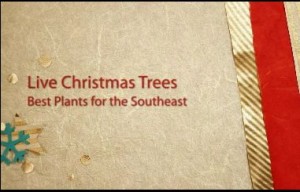
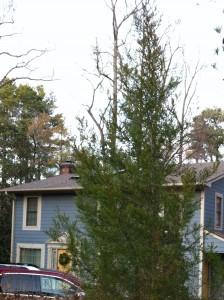
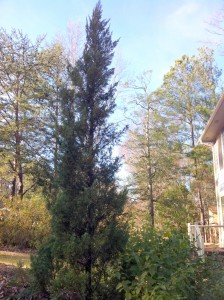

{ 1 comment… read it below or add one }
Hello There. I discovered your weblog using msn. That is a really well written
article. I’ll be sure to bookmark it and return to read more of your helpful information. Thank you for the post. I’ll definitely comeback.